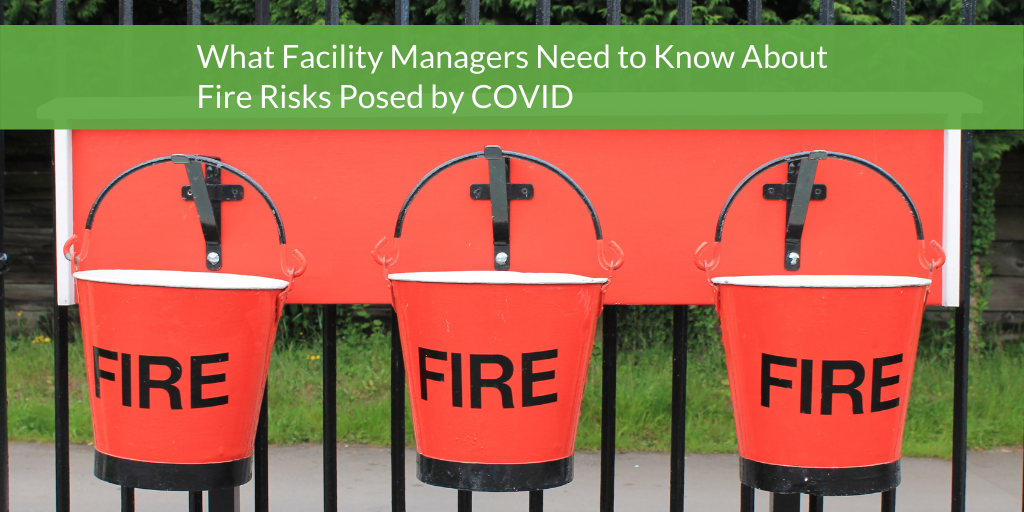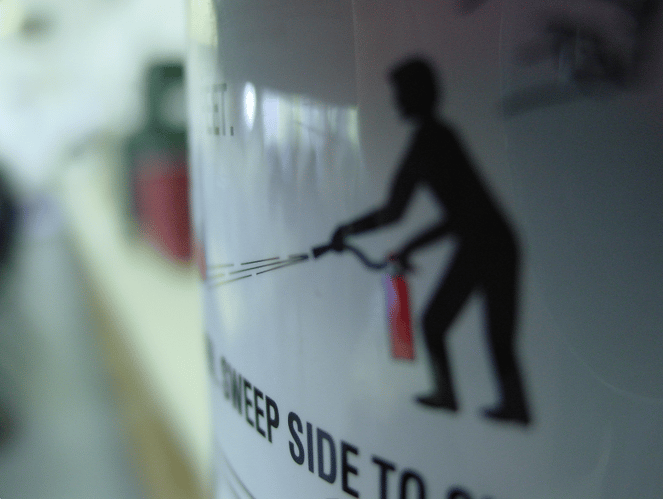Share this
What Facility Managers Need to Know About Fire Risks Posed by COVID
by Phoenix Energy Technologies on Sep 21, 2020

The pandemic has posed several left-field side effects, including a national coin shortage, businesses finding productivity spikes despite employees working from home, and unique challenges in maintaining fire safety in buildings–even though fewer people are in them!
When it comes to fire safety, there are many things facility managers should keep in mind:
- Are you still compliant with all maintenance checks?
- Have you considered the risks skeleton staff pose?
- Are you controlling the increase in combustible risks COVID mitigation plans present?
- Are buildings set to reopen following all the best practices and considerations?
Managing Building Air Quality in a COVID Environment
Maintenance Checks
Depending on the facility's location, facility type, and facility ownership, there are multiple authorities an FM may answer to. Generally, these authorities include:
-
Local authorities (fire department, building department)
-
State authorities (fire marshal, health department)
-
The federal government (OSHA)
-
Private sector (insurance companies, certification/accreditation entities)
LEARN HOW: Optimizing buildings for COVID to Increase Comfort & Safety
Fire Protection Systems
Whether buildings are in use or not, all fire maintenance checks must be up to date. Failure to do so can result in fines and potential litigation. Systems need to be maintained, inspected, and tested regularly.
An excellent list to consult is the National Fire Protection Association's standards and codes. The most common applicable regulations to FMs are:
-
NFPA 72, The National Fire Alarm and Signaling Code - outlining the minimum performance levels for alarms systems, including installation, location, inspection, testing, etc.
- NFPA 25, The Standard for the Inspection, Testing, and Maintenance of Water-Based Fire Protection Systems - covering the maintenance and inspection of sprinkler systems, standpipe systems, etc.
- NFPA 10, The Standard for Portable Fire Extinguishers - covering everything relevant to ensure extinguishers work as intended as the first line of defense
- NFPA 96, Ventilation Control and Fire Protection of Commercial Cooking Operations - listing how to prevent fires in public and private commercial cooking areas
Skeleton Staff
While many buildings are empty due to pandemic shutdowns, it can be easy to ignore posted fire safety warnings. People can become lapse in thinking, "no one is here," and prop open fire safety doors, block fire exits, and fail to take precautions in disposing of large amounts of combustible trash. Some occupants might even pose more direct risks by smoking inside buildings or near flammables since "no one is around."
The best way to handle safety lapses is to conduct frequent sweeps of the property (inside and out) and educate occupants when issues are identified.

Energy Efficiency AND Customer Comfort CAN Co-exist
Combustible Risks
Although hand sanitizer is very much a part of our lives right now, it is crucial to keep in mind how flammable it is. According to the CDC, effective hand sanitizer has an alcohol content above 60-70%, making it a Class 1 flammable liquid easily ignitable at room temperature.
FMs should ensure that only small sanitizer quantities are stored together, free of surrounding fuel or igniting agents. Additionally, if you need to store more than five gallons, proper storage is subject to NFPA 30 standard, which requires storage in a Flammable Liquids Cabinet.
Other combustible risks FMs should monitor include:
- Build up of empty containers that contained flammable liquid
- Dried out office plants that are easily ignitable
- Blocked egress areas
NOTE: You should post warnings of hand sanitizer vapors' danger near an open flame for those locations with nominated smoking areas.
Reopening Considerations
As employees and customers return to your buildings, many COVID safety protocols will have been established and set up that can pose fire safety risks.
Here are things you should check for:
-
Are temporary partitions composed of safe material and hung as not to pose a fire risk?
-
Are plexiglass or fabric partitions blocking emergency exit paths, smoke exhausts, air pathways, fire sprinklers, and detectors?
-
Are additional on-site fire wardens needed due to staggered workforce hours?
-
Has the emergency evacuation plan changed in light of social distancing measures?
-
Are assembly areas appropriate, or should multiple or larger areas be selected?
-
Where elevators were allowed as part of an evacuation plan, should this be changed?
-
Your fire safety plans and drills will need to be re-evaluated and updated as locations reopen. Remember, the best way for you to keep occupants safe is through thorough planning and educating (and re-educating) occupants. Post all new emergency plans in plain sight and hold regular fire and evacuation drills.
Tips on Occupant Comfort
Need tips on how to keep employees comfortable and safe while wearing their PPE?
Please join us in our upcoming webinar Balancing Cost and Comfort: The Case for Always Occupied Setpoints. We will be joined by PetSmart's Energy & Sustainability Manager Rachael Ruelas discussing how she managed comfort and safety across her 1,600 stores and what the impact was on their energy budget. Don't miss out - Register for the webinar below.
Additional COVID Resources for Facility Managers:
Retail Tips for Dealing with COVID Recommendations
How to Manage Building Air Quality in a COVID Environment
Energy Efficiency AND Customer Comfort CAN Co-exist
How To Get Buildings Ready To Reopen Following COVID Closures
Managing Associate and Customer Comfort in Retail's New Normal
Challenges Facing Facility Managers As Social Distancing Is Relaxed And Doors Reopen
Share this
- Facilities Management (91)
- Energy Management (69)
- Company News (49)
- Smart Buildings (37)
- Retail (36)
- Building Management (24)
- Building Automation Systems (21)
- Sustainability (20)
- Energy Demand Management (19)
- EEI (15)
- Adaptive Energy Management (14)
- Grocery (14)
- demand response (14)
- Artificial Intelligence (12)
- Data Integration and Visibility (10)
- HVAC IQ (9)
- COVID-19 (8)
- Customer Spotlight (8)
- Carbon Management (7)
- Setpoints and Temperatures (7)
- Equipment Maintenance (6)
- Operational Efficiency (6)
- Refrigeration Optimization (6)
- Ask Ron (5)
- Asset Manager (5)
- Finance and Procurement (5)
- IoT and Digital Transformation (5)
- Awards (4)
- Comfort (4)
- Energy & Store Development (4)
- Safety and Compliance (4)
- Demand Charge Management (3)
- Energy Management System (3)
- Lifecycle Asset Management (3)
- Premium Services (3)
- Refrigeration IQ (3)
- Automated Demand Response (2)
- ConnexFM (2)
- Customer Service (2)
- HVAC Vendor Management (2)
- Load Shedding (2)
- Technician View (2)
- AIM Act (1)
- ALD (1)
- Analytics (1)
- Data (1)
- Data Integration and Visualization (1)
- EMS (1)
- Knowledge Center (1)
- OSHA (1)
- asset management (1)
- December 2025 (1)
- November 2025 (1)
- October 2025 (2)
- September 2025 (1)
- August 2025 (3)
- July 2025 (1)
- June 2025 (1)
- May 2025 (2)
- March 2025 (2)
- February 2025 (1)
- January 2025 (2)
- December 2024 (2)
- October 2024 (1)
- September 2024 (1)
- August 2024 (2)
- June 2024 (2)
- April 2024 (2)
- March 2024 (2)
- January 2024 (1)
- December 2023 (1)
- October 2023 (2)
- September 2023 (2)
- August 2023 (2)
- July 2023 (1)
- May 2023 (2)
- April 2023 (2)
- March 2023 (3)
- February 2023 (1)
- January 2023 (1)
- December 2022 (1)
- November 2022 (2)
- October 2022 (2)
- September 2022 (1)
- May 2022 (2)
- April 2022 (1)
- March 2022 (3)
- February 2022 (2)
- January 2022 (4)
- December 2021 (2)
- November 2021 (3)
- October 2021 (1)
- September 2021 (3)
- August 2021 (4)
- July 2021 (1)
- June 2021 (2)
- May 2021 (1)
- January 2021 (2)
- December 2020 (2)
- November 2020 (2)
- October 2020 (3)
- September 2020 (4)
- August 2020 (3)
- July 2020 (2)
- June 2020 (3)
- May 2020 (3)
- April 2020 (5)
- March 2020 (5)
- February 2020 (4)
- January 2020 (4)
- December 2019 (4)
- November 2019 (3)
- October 2019 (4)
- September 2019 (5)
- August 2019 (4)
- July 2019 (4)
- May 2019 (2)
- April 2019 (3)
- February 2019 (1)
- December 2018 (1)
- November 2018 (1)
- October 2018 (3)
- September 2018 (3)
- August 2018 (3)
- July 2018 (3)
- June 2018 (3)
- May 2018 (1)
- June 2015 (1)
- March 2013 (1)
- January 2013 (1)
- December 2011 (1)
- October 2011 (1)
- September 2011 (1)

